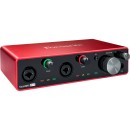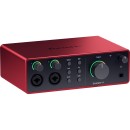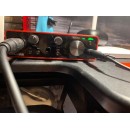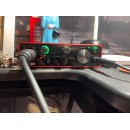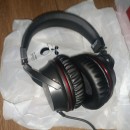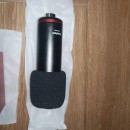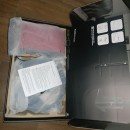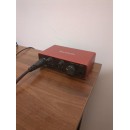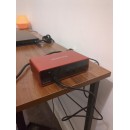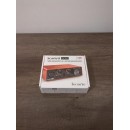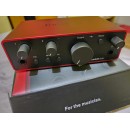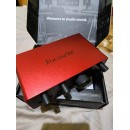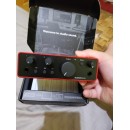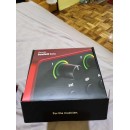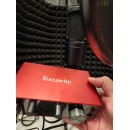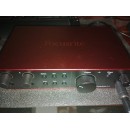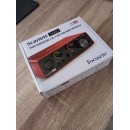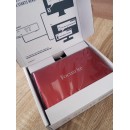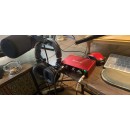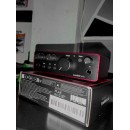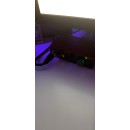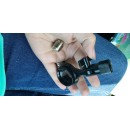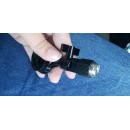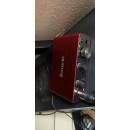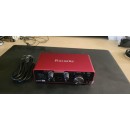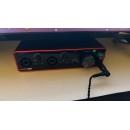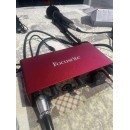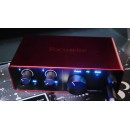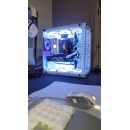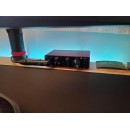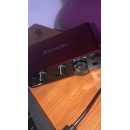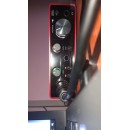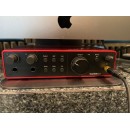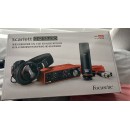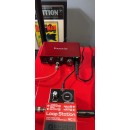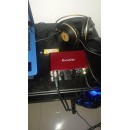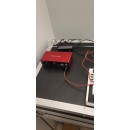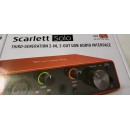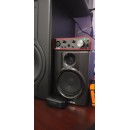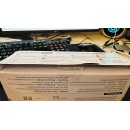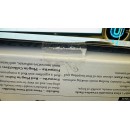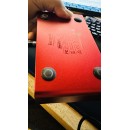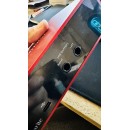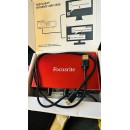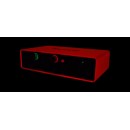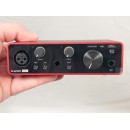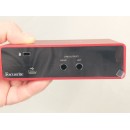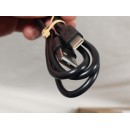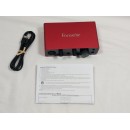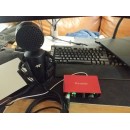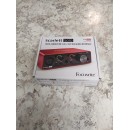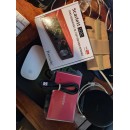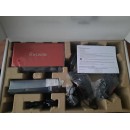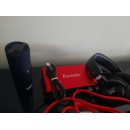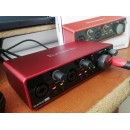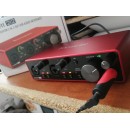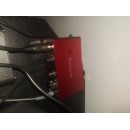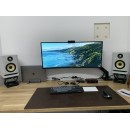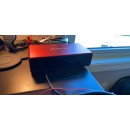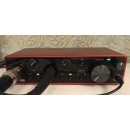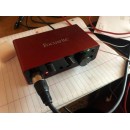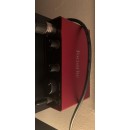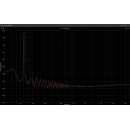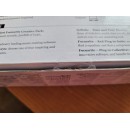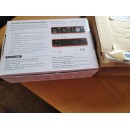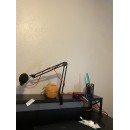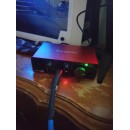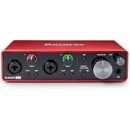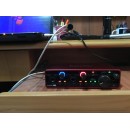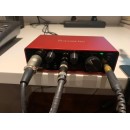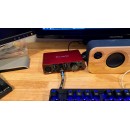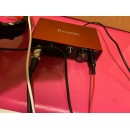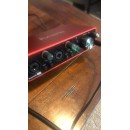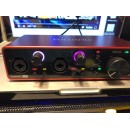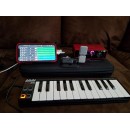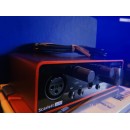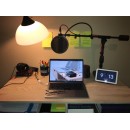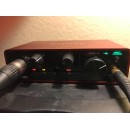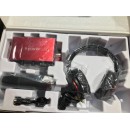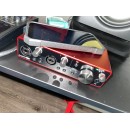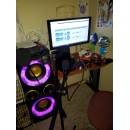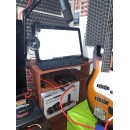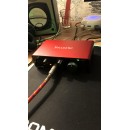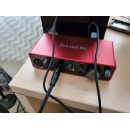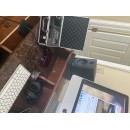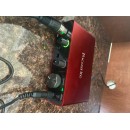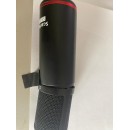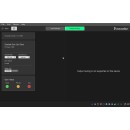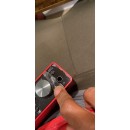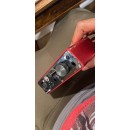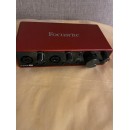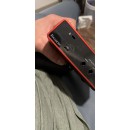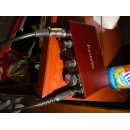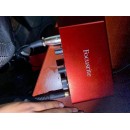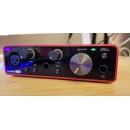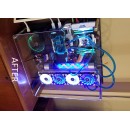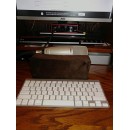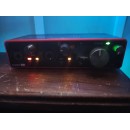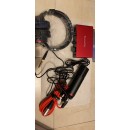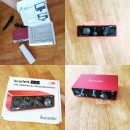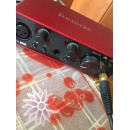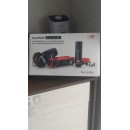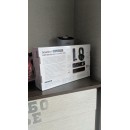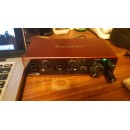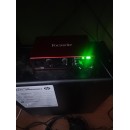Focusrite Scarlett 4i4 4th Generation vs 3rd Generation: Comprehensive Comparison
The 3rd Generation Scarlett 4i4 features two upgraded Scarlett mic preamps with optional Air mode, which emulates the famous Focusrite ISA preamps, enhancing brightness and presence in vocal and acoustic recordings. It offers four balanced line inputs for connecting synthesizers or other line-level sources, along with four balanced outputs for studio monitors or outboard effects. Additionally, it includes MIDI I/O, allowing you to connect MIDI devices. The 3rd Gen Scarlett 4i4 connects via a standard USB-A port, ensuring broad compatibility with various computer systems. Its iconic red metal chassis ensures durability and professional aesthetic.
On the other hand, the 4th Generation Scarlett 4i4 introduces several enhancements that cater to modern recording needs. It features improved preamps for even cleaner and more transparent recordings, along with upgraded Air mode circuitry. A significant upgrade is its USB-C connectivity, which offers faster data transfer rates and improved power management, making it more suitable for contemporary computers and devices. The 4th Gen model retains the same number of inputs and outputs but comes with enhanced software control via the Focusrite Control app, allowing more intuitive routing and mixing capabilities. Additionally, the 4th Generation Scarlett 4i4 boasts a more streamlined and ergonomic design, ensuring it integrates seamlessly into any studio setup.
Both generations deliver high-fidelity audio performance and come with a suite of bundled software, including Ableton Live Lite, Pro Tools First, and various virtual instruments and effects. However, the 4th Generation’s improved preamps, USB-C connectivity, and advanced software integration make it a more future-proof choice for those looking to invest in a long-term audio interface solution.
Specifications, Advantages, and Disadvantages
| User Rating Based on Analysis of Reviews | |
|---|---|
|
Show More |
| Pros: | |
|---|---|
|
|
| Cons: | |
|---|---|
|
|
| Key Specs | |
|---|---|
| Channels of I/O | |
| Analog: 4 Input / 4 Output at 192 kHz |
Analog: 4 Inputs / 4 Outputs at 192 kHz |
| Maximum Sampling Rate | |
| 192 kHz / 24-Bit | 192 kHz / 24-Bit |
| Number of Microphone Inputs | |
| 2 Preamps | 2 |
| Analog Audio I/O | |
| 2x Combo XLR-1/4" TRS Balanced/Unbalanced Mic/Line/Hi-Z Input (Front Panel) 2x 1/4" TRS Balanced Line Input 4x 1/4" TRS Balanced Line Output 1x 1/4" TRS Unbalanced Headphone Output (Front Panel) |
2x Combo XLR-1/4" 3-Pin Balanced/Unbalanced Mic/Line/Hi-Z Input (Front Panel) 2x 1/4" TRS Balanced/Unbalanced Line Input 4x 1/4" TRS Balanced/Unbalanced Line/Monitor Output 1x 1/4" TRS Headphone Output (Front Panel) |
| Host Connection | |
| 1x USB-C | 1x USB-C |
| OS Compatibility | |
| macOS 10.12 or Later Windows 7 or Later |
macOS Windows |
| Power Requirements | |
| USB Bus Power | USB Bus Power, USB Power Adapter (Not Included) |
In terms of channels of Input/Output, both the 3rd and 4th Generation models offer 4 analog inputs and 4 analog outputs at a maximum sampling rate of 192 kHz / 24-Bit. Both models include 2 microphone preamps and provide similar analog audio I/O configurations with 2x Combo XLR-1/4" TRS inputs on the front panel, 2x 1/4" TRS balanced line inputs, 4x 1/4" TRS balanced line outputs, and a 1/4" TRS unbalanced headphone output located on the front panel.
One notable difference lies in the specification of the analog audio I/O. While the 3rd Generation model features 2x Combo XLR-1/4" TRS Balanced/Unbalanced Mic/Line/Hi-Z Inputs and 4x 1/4" TRS Balanced Line Outputs, the 4th Generation model specifies these as 2x Combo XLR-1/4" 3-Pin Balanced/Unbalanced Mic/Line/Hi-Z Inputs and 4x 1/4" TRS Balanced/Unbalanced Line/Monitor Outputs. This suggests that the 4th Generation model has enhanced versatility in output configurations.
Regarding the host connection, both models use USB-C, ensuring high-speed and reliable data transfer. However, the 4th Generation model offers broader OS compatibility, supporting general macOS and Windows systems, while the 3rd Generation model specifies compatibility with macOS 10.12 or later and Windows 7 or later.
Power requirements for both interfaces include USB bus power, but the 4th Generation model additionally supports a USB power adapter (not included), potentially providing more stable power options for users.
In summary, while both the 3rd and 4th Generation Focusrite Scarlett 4i4 interfaces share many core features such as sampling rate, number of microphone inputs, and host connection type, the 4th Generation model provides more comprehensive analog audio I/O specifications and broader OS compatibility, along with an additional power option via a USB power adapter.
| General | |
|---|---|
| Channels of I/O | |
| Analog: 4 Input / 4 Output at 192 kHz |
Analog: 4 Inputs / 4 Outputs at 192 kHz |
| Maximum Sampling Rate | |
| 192 kHz / 24-Bit | 192 kHz / 24-Bit |
| Number of Microphone Inputs | |
| 2 Preamps | 2 |
| Input Level Adjustment | |
| 2x Knob | 2x Knob |
| Expansion Slots | |
The 3rd Generation Scarlett 4i4 features two microphone preamps with input level adjustments controlled by two knobs. Importantly, it does not have built-in DSP or expansion slots, which might be a consideration for users looking for more advanced features or future expandability.
Similarly, the 4th Generation Scarlett 4i4 also includes two microphone inputs and input level adjustments via two knobs. However, it introduces a USB-C connection, which can provide faster data transfer rates and improved connectivity with modern devices. Like its predecessor, the 4th Generation does not include built-in DSP or expansion slots, and it also lacks a built-in microphone.
In summary, while both the 3rd and 4th Generation Scarlett 4i4 interfaces offer high-quality audio performance with identical input/output channels and sampling rates, the 4th Generation distinguishes itself with a USB-C port, aligning with contemporary connectivity standards. Both generations maintain the same level of simplicity and efficiency, with no built-in DSP or expansion slots, catering to users who need reliable, straightforward audio interfaces.
| Signal Processing | |
|---|---|
| Gain/Trim Range | |
| Inputs: Up to +56 dB |
Mic/Line Inputs: Up to +69 dB Hi-Z Inputs: 62 dB |
The 3rd Generation Scarlett 4i4 includes a pad function for its Mic/Line/Hi-Z inputs, providing a -10 dB attenuation that is switchable per channel. This generation offers a gain/trim range of up to +56 dB on its inputs but lacks a high-pass filter and solo/mute functionality.
In contrast, the 4th Generation Scarlett 4i4 offers a more substantial gain/trim range, with Mic/Line inputs reaching up to +69 dB and Hi-Z inputs up to +62 dB. This suggests an improvement in preamp performance and input headroom over the previous generation.
While both interfaces serve similar purposes, the 4th Generation Scarlett 4i4 provides enhanced gain capabilities and adopts the modern USB-C connection standard, likely offering better connectivity and power management.
| Connectivity | |
|---|---|
| Analog Audio I/O | |
| 2x Combo XLR-1/4" TRS Balanced/Unbalanced Mic/Line/Hi-Z Input (Front Panel) 2x 1/4" TRS Balanced Line Input 4x 1/4" TRS Balanced Line Output 1x 1/4" TRS Unbalanced Headphone Output (Front Panel) |
2x Combo XLR-1/4" 3-Pin Balanced/Unbalanced Mic/Line/Hi-Z Input (Front Panel) 2x 1/4" TRS Balanced/Unbalanced Line Input 4x 1/4" TRS Balanced/Unbalanced Line/Monitor Output 1x 1/4" TRS Headphone Output (Front Panel) |
| Phantom Power | |
| 48 V, Selectable On/Off (on 2 Channels) | 48 V, Selectable On/Off |
| Digital Audio I/O | |
| Host Connection | |
| 1x USB-C | 1x USB-C |
| Host Connection Protocol | |
| USB 2.0 | USB 2.0 |
| MIDI I/O | |
| 1x DIN 5-Pin Input 1x DIN 5-Pin Output |
1x DIN 5-Pin Input 1x DIN 5-Pin Output |
Both interfaces offer 2x Combo XLR-1/4" TRS Balanced/Unbalanced Mic/Line/Hi-Z Inputs on the front panel and 2x 1/4" TRS Balanced Line Inputs. They also provide 4x 1/4" TRS Balanced Line Outputs and a 1x 1/4" TRS Unbalanced Headphone Output on the front panel. Additionally, both models support 48 V phantom power, which is selectable on/off.
In terms of digital audio I/O, neither model includes this feature. Both interfaces use a USB-C connection for the host connection protocol, adhering to USB 2.0 standards. MIDI I/O is consistent across both models, featuring 1x DIN 5-Pin Input and 1x DIN 5-Pin Output.
The primary differences lie in the output capabilities and power input. The 4th Generation Scarlett 4i4 includes 4x 1/4" TRS Balanced/Unbalanced Line/Monitor Outputs, whereas the 3rd Generation model only specifies 4x 1/4" TRS Balanced Line Outputs. Another key difference is that the 4th Generation model features an additional USB-C port intended for power input, which is not present in the 3rd Generation model.
Overall, while both generations share many fundamental features, the 4th Generation model offers enhanced flexibility with its additional power input and more versatile output options.
| Performance | |
|---|---|
| Frequency Response | |
| Inputs: 20 Hz to 20 kHz ±0.1 dB |
Combo XLR-1/4" Mic Inputs: 20 Hz to 20 kHz ±0.06 dB Combo XLR-1/4" Line Inputs: 20 Hz to 20 kHz ±0.05 dB Combo XLR-1/4" Hi-Z Inputs: 20 Hz to 20 kHz ±0.15 dB 1/4" Line Inputs: 20 Hz to 20 kHz ±0.02 dB |
| Maximum Input Level | |
| Mic Inputs: +9 dBu (Min Gain) +16 dBu (Min Gain, with Pad) Hi-Z Inputs: +12.5 dBu (Min Gain) +14 dBu (Min Gain, with Pad) Line Inputs: +22 dBu (Min Gain) +29 dBu (Min Gain, with Pad) |
Combo XLR-1/4" Mic: 16 dBu Combo XLR-1/4" Line: 22 dBu Combo XLR-1/4" Hi-Z: 12 dBu 1/4" Line: 22 dBu |
| Maximum Output Level | |
| Monitor/Line Outputs: +15.5 dBu at 0 dBFS Headphone Outputs: +7 dBu |
1/4" Line: +16 dBu |
| Impedance | |
| Mic Inputs: 3 Kilohms Hi-Z Inputs: 1.5 Megohms Line Inputs: 60 Kilohms Line Outputs: 430 Ohms Headphone Outputs: < 1 Ohm |
Combo XLR-1/4" Mic Inputs: 3 Kilohms Combo XLR-1/4" Line Inputs: 60 Kilohms Combo XLR-1/4" Hi-Z Inputs: 1 Megohms 1/4" Line Inputs: 60 Kilohms 1/4" Line Outputs: 100 Ohms 1/4" Headphone Outputs: < 11 Ohm |
| Dynamic Range | |
| Mic Inputs: 111 dBA Hi-Z Inputs: 110 dBA Line Inputs: 110.5 dBA Line Outputs: 108 dBA Headphone Outputs: 104 dBA |
Combo XLR-1/4" Mic Inputs: 116 dBA Combo XLR-1/4" Line Inputs: 115.5 dBA Combo XLR-1/4" Hi-Z Inputs: 113 dBA 1/4" Line Inputs: 115.5 dBA 1/4" Line Outputs: 120 dB 1/4" Headphone: 112 dB (at 33 Ohms) 115 dB (at 300 Ohms) Digital A/D Converters: 130 dB Digital D/A Converters: 130 dBA |
| THD+N | |
| Mic Inputs: < 0.0012% Hi-Z Inputs: < 0.03% Line Inputs: < 0.002% Line Outputs: < 0.002% Headphone Outputs: < 0.002% |
Combo XLR-1/4" Mic Inputs: -100 dB (at 8 dB Gain) Combo XLR-1/4" Line Inputs: -100 dB (at 8 dB Gain) Combo XLR-1/4" Hi-Z Inputs: -80 dB (at Minimum Gain) 1/4" Line Inputs: -105 dB 1/4" Line Outputs: -112 dB 1/4" Headphone Outputs: -99 dB (at 33 Ohms) -108 dB (at 300 Ohms) Digital A/D Converters: -115 dB Digital D/A Converters: -115 dB |
| EIN | |
| Mic Inputs: -128 dBu A-Weighted |
Combo XLR-1/4" Mic Inputs: -127 dBu A-Weighted |
Frequency Response:
The 3rd Generation Scarlett 4i4 offers a frequency response of 20 Hz to 20 kHz with a ±0.1 dB variation across its inputs. In contrast, the 4th Generation model provides a more nuanced frequency response with different tolerances for each input type: ±0.06 dB for Combo XLR-1/4" Mic inputs, ±0.05 dB for Combo XLR-1/4" Line inputs, ±0.15 dB for Combo XLR-1/4" Hi-Z inputs, and ±0.02 dB for 1/4" Line inputs. This indicates a more detailed and precise frequency response management in the 4th Generation.
Maximum Input Level: The 3rd Generation Scarlett 4i4 has different maximum input levels depending on the gain and pad settings: +9 dBu to +29 dBu for various inputs. The 4th Generation model simplifies this with set maximum input levels: 16 dBu for Combo XLR-1/4" Mic, 22 dBu for Combo XLR-1/4" Line and 1/4" Line inputs, and 12 dBu for Combo XLR-1/4" Hi-Z inputs.
Maximum Output Level: The 3rd Generation has a maximum output level of +15.5 dBu for monitor/line outputs and +7 dBu for headphone outputs. The 4th Generation model offers a slightly higher maximum output level of +16 dBu for 1/4" Line outputs and specifies headphone output power in milliwatts: 57 mW into 33 Ohms and 27 mW into 300 Ohms.
Impedance: For impedance, the 3rd Generation Scarlett 4i4 lists values such as 3 Kilohms for Mic inputs, 1.5 Megohms for Hi-Z inputs, 60 Kilohms for Line inputs, and 430 Ohms for Line outputs. The 4th Generation has similar impedance values for its Combo XLR-1/4" inputs but shows a lower impedance of 1 Megohms for Hi-Z inputs, 100 Ohms for Line outputs, and less than 11 Ohms for headphone outputs.
Dynamic Range: The dynamic range has been significantly improved in the 4th Generation. While the 3rd Generation offers up to 111 dBA for Mic inputs and 104 dBA for headphone outputs, the 4th Generation boasts up to 116 dBA for Mic inputs and up to 120 dB for Line outputs. The 4th Generation also includes dynamic range values for its digital converters, both A/D and D/A, at 130 dB and 130 dBA respectively.
THD+N: The Total Harmonic Distortion plus Noise (THD+N) is lower in the 4th Generation model across all inputs and outputs. The 3rd Generation lists values such as less than 0.0012% for Mic inputs and less than 0.002% for Line outputs, whereas the 4th Generation shows values like -100 dB for Combo XLR-1/4" Mic and Line inputs and -112 dB for 1/4" Line outputs, indicating lower distortion levels.
EIN: The Equivalent Input Noise (EIN) for the Mic inputs is slightly improved in the 4th Generation at -127 dBu A-Weighted compared to -128 dBu A-Weighted in the 3rd Generation, although the difference is minimal.
In summary, the Focusrite Scarlett 4i4 USB-C Audio/MIDI Interface (4th Generation) shows enhancements in frequency response precision, input/output levels, dynamic range, and THD+N values, reflecting significant upgrades over the 3rd Generation model.
| Digital Audio | |
|---|---|
| Sample Rates | |
| Up to 192 kHz (AD/DA Conversion) | 44.1 / 48 / 88.2 / 96 / 176.4 / 192 kHz |
| Bit Depths | |
| Up to 24-Bit (AD/DA Conversion) | 24-Bit |
| Sync Sources | |
| Internal | Internal |
Regarding the sample rate conversion, the 3rd Generation model does not offer sample rate conversion, whereas the 4th Generation specifications do not explicitly mention this feature, potentially indicating consistency with the previous model in this aspect. Both interfaces use internal sync sources to maintain accurate timing for audio and MIDI data, ensuring reliable performance in various recording environments.
In summary, both the 3rd and 4th Generation Focusrite Scarlett 4i4 interfaces deliver professional-grade audio performance with similar specs in sample rates and bit depths. The primary distinction lies in the connectivity, where the 4th Generation employs USB-C, likely offering enhanced data transfer rates and compatibility with newer devices.
| Audio Storage & Playback |
|---|
| Compatibility | |
|---|---|
| OS Compatibility | |
| macOS 10.12 or Later Windows 7 or Later |
macOS Windows |
The 3rd Generation Scarlett 4i4 is compatible with macOS 10.12 or later and Windows 7 or later, while the 4th Generation Scarlett 4i4 supports both macOS and Windows without specifying the versions, indicating broader and possibly more up-to-date compatibility. Additionally, the 3rd Generation does not support mobile device compatibility, whereas the 4th Generation adds compatibility with iPadOS, enhancing its versatility for mobile use.
In terms of hardware requirements, the 3rd Generation Scarlett 4i4 requires an available USB 2.0 port and comes with a USB cable included. It also necessitates an internet connection for software and driver downloads. The specifications for hardware and internet connection requirements for the 4th Generation are not specified but can be inferred to be similar with potentially modernized connectivity options, given the transition to USB-C.
Overall, the 4th Generation Scarlett 4i4 offers expanded OS compatibility, including mobile app compatibility with iPadOS, which is not available in the 3rd Generation. These enhancements make the 4th Generation more adaptable and convenient, especially for users who rely on mobile devices for their audio production needs.
| Power | |
|---|---|
| Power Requirements | |
| USB Bus Power | USB Bus Power, USB Power Adapter (Not Included) |
In contrast, the Focusrite Scarlett 4i4 USB-C Audio/MIDI Interface (4th Generation) offers more versatile power options. It can still operate using USB bus power like its predecessor, but it also supports an external USB power adapter (not included) and comes with an AC/DC power adapter rated at 5 VDC and 3 A. This additional power option can ensure more consistent performance and reliability, especially in more demanding recording environments. The 4th Generation model has a power consumption rating of 7.5 W, indicating its potential for more advanced features and improved performance.
In summary, while both models can function using USB bus power, the 4th Generation Scarlett 4i4 provides supplementary power options with an included AC/DC power adapter, offering greater flexibility and potentially enhanced performance for users who need it.
| Physical | |
|---|---|
| Dimensions | |
| 7.28 x 4.71 x 1.87" / 18.49 x 11.96 x 4.75 cm | 7.09 x 5.08 x 2.32" / 18.01 x 12.9 x 5.89 cm |
| Weight | |
| 1.4 lb / 0.6 kg | 1.8 lb / 816.0 g |
The 3rd Generation Scarlett 4i4 includes an anti-theft feature in the form of a Kensington Security Slot, which allows for added security. In terms of physical dimensions, it measures 7.28 x 4.71 x 1.87 inches (18.49 x 11.96 x 4.75 cm) and weighs 1.4 pounds (0.6 kg). This makes the 3rd Generation model relatively compact and lightweight, suitable for both desktop and portable use.
On the other hand, the 4th Generation Scarlett 4i4 has slightly different dimensions, measuring 7.09 x 5.08 x 2.32 inches (18.01 x 12.9 x 5.89 cm) and weighing 1.8 pounds (816.0 g). The updated model is marginally smaller in length but slightly larger in width and height compared to its predecessor. Additionally, it is a bit heavier, which might be indicative of internal upgrades or enhanced build quality.
Overall, the 3rd Generation model offers a Kensington Security Slot for anti-theft protection and is slightly more compact and lighter, whereas the 4th Generation model is a bit larger and heavier, potentially offering other improvements in design and functionality while omitting the Kensington Security Slot.
| Packaging Info | |
|---|---|
| Package Weight | |
| 1.81 lb | 3.185 lb |
| Box Dimensions (LxWxH) | |
| 8.5 x 6.5 x 2.4" | 11.2 x 8 x 3.6" |
These differences indicate that the 4th Generation model is larger and heavier than its predecessor, which may reflect enhancements in build quality or additional components. The increased size and weight could also suggest a more robust design or potentially more advanced technology housed within the 4th Generation interface.
| Customer Images | |
|---|---|
| Videos | |
|---|---|
|
|
|
